Know how to add sub-users to create more visibility in your hiring goals.
Most recruitment teams consisting of interviewers, recruiters, and hiring managers are involved in skill-testing and interviewing candidates. Their work may vary from creating a test, selecting the questions, inviting candidates for tests, taking interviews, and so on. It is important that you have your entire team together to make collective and accurate decisions.
iMocha now helps you add them as a user and decide the access levels according to your requirements.
How to add a user?
- Go to Settings -> Global Settings -> Users.

- Click Add User, and enter the user's email ID and full name. Select the Business Unit from the drop-down. If the business unit is not in the drop-down list, select Add New BU to add a new Business Unit.

- Select the role which you want to give the user (Admin, Recruiter, Interviewer, Test Creator, Hiring Manager, External Recruiter, and Reviewer).

- Select the access level for the user.
- Click Save.
A pop-up appears with the login details.
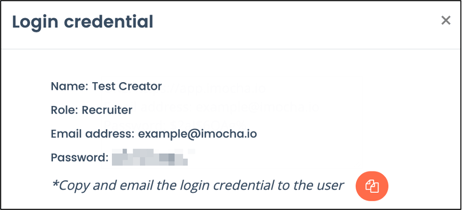
Copy the login details and send them to the new user. The user can change this default password while logging in for the first time.
Note: You cannot add the user who is already registered with iMocha. If you want to add them as a user, drop an email to support@imocha.io
The super admin and admin can Activate/Inactivate a user.
Different User Roles and Access levels:
- Admin: Admin acts like a second-in-command to the Super Admin. Admin has all the access rights along with the critical settings and company level settings. Admin, by default, has all the access rights. You can add a team member as admin and allow full access, or you can select their access level. Once you have created an admin, the admin can add co-admins or other team members to their account.
Super Admin and Admin can edit access levels of users irrespective of their roles. - Recruiter: Recruiters are typically team members who are entrusted with the initial screening of candidates. They usually send test invites and shortlist candidates for further interviews. In the default access, the recruiter does not have access to Global Settings, and Candidate feedback under Analytics
The above is default access rights; however,Super Admin and Admin can edit users' access levels irrespective of their roles. - Interviewer: The interviewer's role is for teammates responsible for conducting interviews for the shortlisted candidates. The interviewer primarily has access to view and download test reports. Super Admin or Admin can decide to allow the other access as well. If you assign the interviewer role to your colleague and access only view and download reports, they will not view the My Questions and Analytics tab. Under Settings, they will only be able to view My Settings, API docs, and Pricing.
Similarly, they cannot add any test from the test library to My Tests. Their My Tests account will contain tests shared with them. - Test Creator: The test creator is responsible for all aspects of test creation, right from selecting the question types, test duration, and sharing tests with recruiters. Test Creator role has default access to Tests, Reports, and My Questions.
Super Admin or Admin can decide to allow the other access as well. - Hiring Manager: The hiring manager is usually the team member who creates the job description and is responsible for conducting interviews based on the assessment reports. Hiring Manager has default access to Reports and Analytics.
- HR Manager: The HR manager is generally a senior-level manager in the HR department. HR managers would typically be viewing reports and analytics related to their team.HR Manager has default access to Reports and Analytics.
- External Recruiter: External recruiter is not a part of your organization but helps you recruit. E.g., a staffing company. Typically, they should have access to invite candidates and view, share, download reports. External recruiter, by default, gets access to Invite and Reports.
- Reviewer: The reviewer role is assigned to teammates who can manually review and score a candidate report.
Note: Super Admin and Admin can edit access levels of users irrespective of their roles.
Access levels and impact:
Below are the access levels and their impact:
- Test
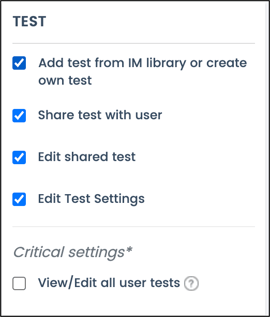
- Add Test from iMocha library OR Create Own Test
Users will get access to add test from the iMocha test library or create a test into their accounts. - Share Test with users
Users will get access to share iMocha's test or a test created by them with another user. - Edit shared Test
Users will get access to edit any tests shared with them. - Edit Test Settings
Users will get access to edit test settings - Critical Settings - View/Edit all user tests
When a user is granted this access, they can view and edit the tests users created in users particular account. We recommend granting this access only to admin users.
Note - Add Test has to be enabled for the user to share the test with other users.
- Add Test from iMocha library OR Create Own Test
- Invite

- Invite candidate
Users will get access to invite candidates for tests. - Create Test Link
Users will get access to create test links.
Tips to remember
A user who has been granted access to invite candidates can view the reports only if view reports access is granted. If the user only has to Invite candidate access, they won’t view the reports.
- Invite candidate
- Reports
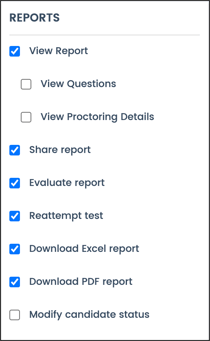
- View Reports
In view reports, the access rights are further divided. When only View Report access is granted, the user can only view the summary. They will not be able to see Questions and Proctoring details. To enable a user to view questions and proctoring details, you will have to tick the respective checkboxes. - Share report
Users will get access to share reports with other users (provided the users are added to their accounts) - Reattempt Test
Users will get access to allow candidates to reattempt the test. - Download Excel Report
Users will get access to download reports in Excel format - Download PDF Report
Users will get access to download reports in PDF format - Modify candidate status
Users will get access to modify the candidate status in reports
- View Reports
- My Questions
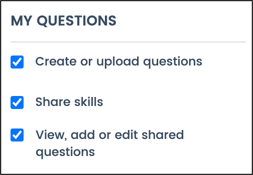
- Create or upload Questions
Users will get access to create and upload questions in their created question banks. - Share skills
Users will get access to share the created question banks with other users. - View, add, or edit shared questions
Users will get access to edit questions that are shared with them.
- Create or upload Questions
- Analytics
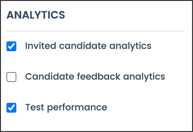
- Invited Candidate Analytics
Users will get access to analytics for invited candidates. - Candidate feedback Analytics
Users will get access to analytics for candidate feedback - Test Analytics
Users will get access to analytics for tests. - Advance search analytics
Users will get access to analytics for advanced search. - Recruiter Performance Analytics
Users can view the sub-users' performance in their account in terms of Test links created, sent, no. of candidates appeared, test status, and the test percentage.
- Invited Candidate Analytics
- Global Settings

- Company details
Users will get access to view and edit company details. - Test landing page
Users will get access to view and edit the landing page URL for the test platform. - Activity log
Users will get access to view activity log. - User management
Users will get access to add, edit access rights, and activate/inactivate other users. - Business Unit Settings
Users will get access to create, edit, and activate/inactivate the business units. - Email templates
Users will get access to access and edit various email templates. - Billing history
Users will get access to view the billing history. - Email domain settings
Users will get access to enable email domain settings. Email domain settings allow you to configure your company email address, for example, xyz@abc.com instead of noreply@imocha.com. - Candidate status settings
Users with this access will be able to customise the candidate status settings. - Master settings - Test
Users with access to master settings can create a global master template for test settings, which will be uniform for all the new tests created in their account by them or by sub-users. We recommend enabling this setting only for Admin level users.
- Company details
For any issues, mail us at support@imocha.io.